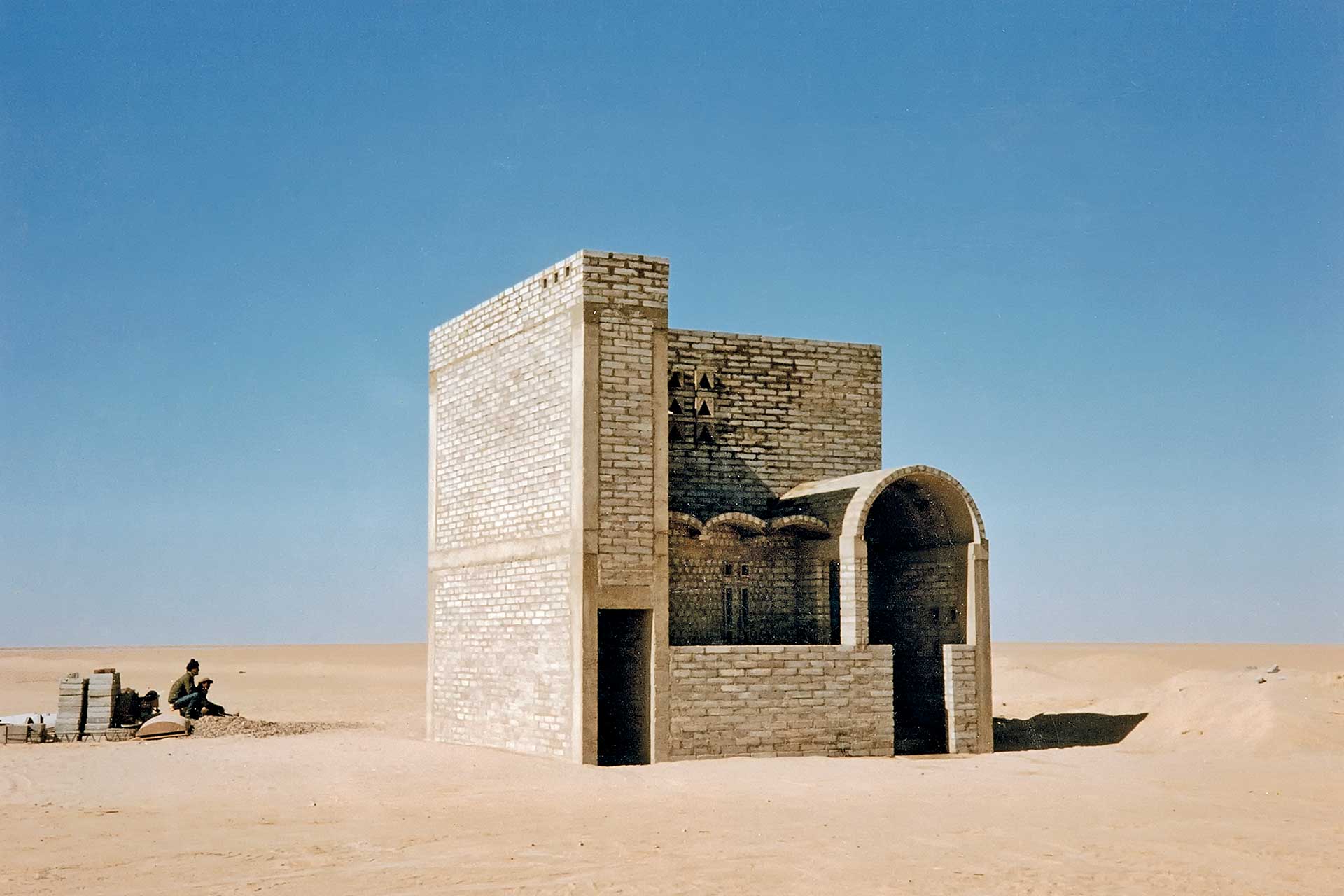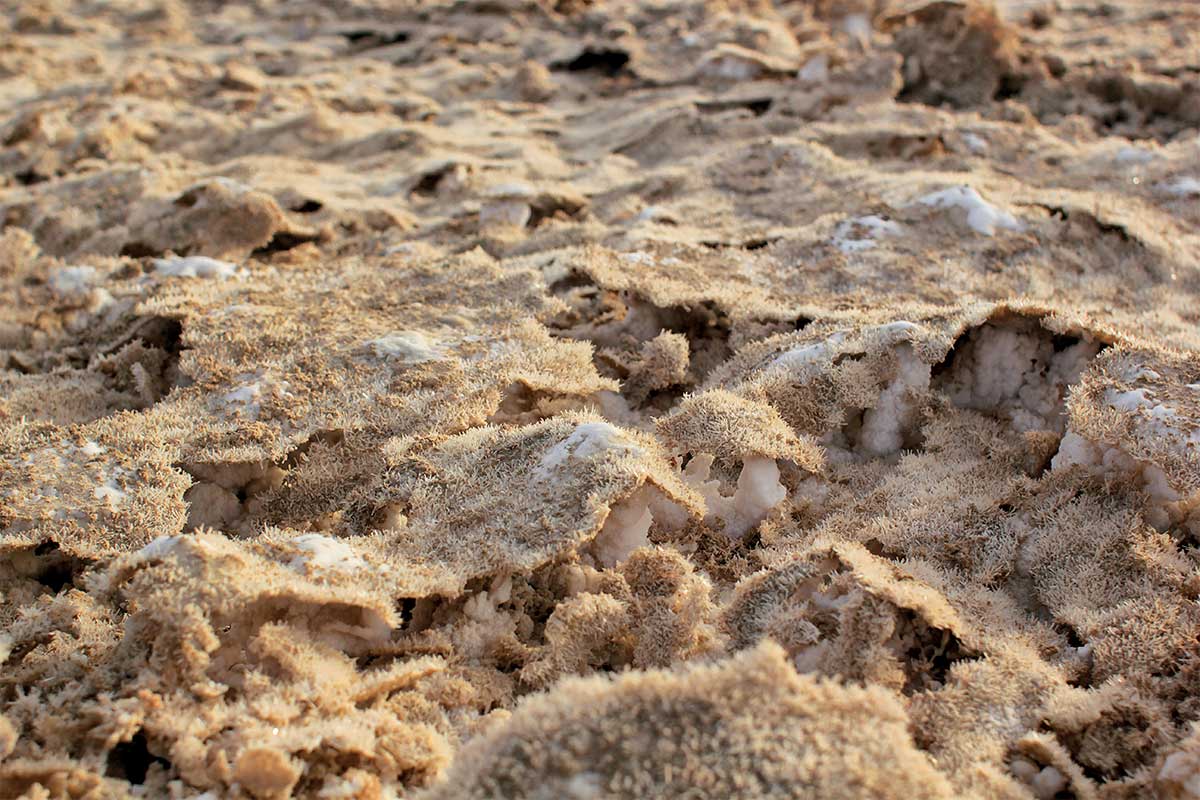The Anatomy of Sabkhas: preserving sustainable salt flats book, written by urbanists Rashid and Ahmed Bin Shabib, provide an urban research of the phenomenon and possible applications
The Anatomy of Sabkhas – the book
In 2021, the UAE’s National Pavilion won the Golden Lion for Best National Participation at 17th Venice Architecture Biennale 2021 with the exhibition titled Wetland. It recreated a material which is similar to cement but is salt-based and environmentally sustainable. The publication that supported and created the conceptual framework for the exhibition, The Anatomy of Sabkhas, was written by urban researchers, Rashid and Ahmed Bin Shabib. Since 2015, while working on a house project in the mountains, they started thinking about the role of materials in architecture. Out of the indigenous materials that already existed one of the first ones they thought of was salt.
What they thought strange was the lack of exploration in the use of this material even if in the contemporary era, for example, it was used for bricks in construction. The connection between the gulf desert areas in UAE and the oceanic presence helped push this research towards an architectural direction. This was done in order to promote a connection between salt as a material of construction and the city of Dubai, explains Ahmed Bin Shabib. The book consists of two different sections which examine the salt and its relationship with architecture. The first part focuses on salt in ecology, understanding what mangroves are, what salt lakes are and how animal’s migration patterns are around these areas. The second section regards the use of salt in architecture and reconstructing a historical period starting from 300 AC. looking both at the construction and archeological sides.
Salt flats in United Arabian Emirates: a natural phenomenon
The Arabic term used for them is sabkha. They are commonly found where the climate is arid or semi-arid, in coastal lowlands that allow the accumulation of evaporative salts. The particular aspect of this phenomenon, according to Bin Shabib, is its presence in the middle of the desert. He explains that they form in areas where no one could expect any scent of life, such as the Persian Gulf in UAE. Thanks to the degree of evaporation due to the level of desert temperatures, the proximity of great sources of water that are located under the desert create a snare above the sand or mud on which the salt then goes to deposit.
The origin and development of these territories happen within environments that act as catalysts to evaporation which is characterized by high carbonate concentrations. There are then different instances of development, such as an initial rise in sea level relative to coastal areas: as they silt up or sea level falls the entrained water evaporates, leaving a salt flat. A characteristic of these territories is the presence of biodiversity both in terms of animals, such as flamingos, and in terms of plants, such as mangroves. The researcher explains that this plant has the ability to recover water resources from the oceans by desalinizing them to convert and consume them as nutrients. In this way, an additional type of energy is created and conserved, used by mangroves to sequester carbon.
Ecological benefits of a natural phenomenon
The insistence on research and conservation of these areas derives not only from the need to study the phenomenon and its evolution according to climate change, but also to prepare for the progress that these will bring in terms of modification of territorial assets and resource management. Salt flats represent a complex environment to be analyzed in its components in order to understand how to create alternatives to the actions and materials used to date. One of the natural benefits understood through these studies, is the possibility of representing part of the solution to climate change and carbon emissions. Bin Shabib reports that, per square meter compared to rainforests, mangroves growing within salt flats are able to sequester four times more carbon because it needs more energy to desalinate water.
Another aspect to be considered is the salt material itself and its potentialities, rediscovering its characteristics also employed in the past as having the ability to preserve food, continues Bin Shabib. Research on salt deserts also explores the importance of their existence, within a more complex environment, and the damage created over time by climate change. These salt flats, and their optimal preservation, are essential and responsible for the progression of natural processes such as plant development and animal migration. Bin Shabib comments on the need for conservation of this phenomenon stating: «looking at these saline environments along the coasts, near the oceans, and including the biodiversity studied, it is clear what the natural complexity of this environment is and its ability to create a continuous and different narrative».
Architecture applications of salt culture
Since 300 AC, through the use of seawater, salt has been used in construction and architecture. The excursus that is offered in the book, analyzes the different perspectives that have been followed over the years up to the contemporary period with Philip Johnson. In the Seventies, he used salt bricks for the construction of the towers in Manhattan. The mixture of scientific and more historical studies done during the research, has enabled the creators’ exhibition to start thinking about how to use salt as a new type of concrete, explains Bin Shabib. It is necessary to think about how the salt flats environment, not oftentimes traceable, can be inserted within a new model, to be rethought with respect to today’s architectural identity.
Bin Shabib stresses the concept of reimagining the surrounding, and architectural, environment starting with the use of salt as a raw material for construction. This concept was the initial point for the conception and construction of the book and research-related exhibit, featured at the Biennale, entitled, Wetland. «This presented a prototype of an environmentally friendly cement alternative made from recycled industrial waste brine salt, which could reduce the construction industry’s impact on the environment». In addition to the idea of exploiting salt as concrete in construction, Bin Shabib reflects on the broader meaning of the material’s ability to crystallize to form a structure.
«It would be possible to think about a form of salt bricks that would have the ability to conserve energy by transforming it into power. In the Middle East where there is a lot of sun and a lot of heat this would penetrate the brick and the energy could be stored. There is no single universal solution, we need to rethink the use of this material». Mies Van der Rohe was the first to look at salt as a building material. Later, with the evolution of building structures and the use of salt as a material good in economic exchanges or in the storage of goods, this idea was put aside. In the book, they look at salt as a way to change conditions. Bin Shabib explains that the first person who had the ability to create a master plan for a city was Cedric Leduc. He was the first to re-imagine the environment around salt construction and preservation, and from there came the idea of creating a utopian city that inspired the following architects.
Lampoon reporting: preserving Sustainable Salt Flats
The book doesn’t want to be conclusive or to determine and judge the development; it wants to open a conversation around the natural phenomenon of salt flats and the perspectives in the use of the main component: the salt. Winning the Golden Lion for Best National Participation is attributed by researchers to the curators’ ability to have commissioned a topic by taking a solution-oriented approach to propose a tangible, non-speculative solution. In addition to the reuse of raw material, inspired by basic indigenous actions practiced anciently, when analyzed as a whole, the Sabkhas phenomenon achieves several objectives.
Another ability of these salt flats is to store extractable energy along with the salt. This allows for energy conservation, which Bin Shabib considers could be a new form of oil. As the author explains, the performance of salt flats demonstrates and highlights how climate change is evolving through their recession or inability to regenerate rapidly. Not regenerating is the same as melting ice, and this indicates the existence of a climatic pattern. Through the research, architecture can be rethought from an unusual perspective that allows for the proper integration, rather than destruction and damage of its surrounding environment.
According to Bin Shabib, the power that the human being has by finding himself at the center of a system that allows him to modify his surroundings has been misused, setting up a mistreating attitude. It then becomes essential to think of forms that do not follow only the human purpose and need, but that are in harmony with what surrounds him; researches on these salt deserts, present not only close to the coasts in the UAE but also in Saudi Arabia and North Africa, represent a starting point for the use of this natural material. The evolution and architectural hypotheses mentioned above, open up future possibilities of construction that, with the passage of time, do not become harmful to the environment in which they are established or do not require disposal.
Rashid and Ahmed bin Shabib brothers
Urbanists and researchers, authors of The Anatomy of Sabkhas: Preserving Sustainable Salt Flats, are both involved in the urbanism sector and graduated from Oxford University. They have also been nominated for the Aga Khan Award for Architecture in 2010 and 2019.




















